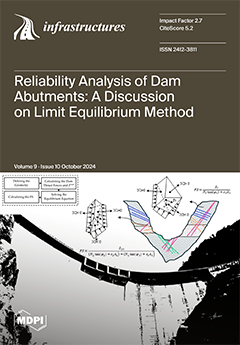This research work aims to compare the strength and fracture mechanics properties of plain concretes, obtained from different coarse aggregates. During the study, mechanical parameters including compressive strength (
fcm) and splitting tensile strength (
fctm), as well as
[...] Read more.
This research work aims to compare the strength and fracture mechanics properties of plain concretes, obtained from different coarse aggregates. During the study, mechanical parameters including compressive strength (
fcm) and splitting tensile strength (
fctm), as well as fracture parameters involving critical stress intensity factor
and critical crack tip opening displacement (
CTODc) were evaluated. The effect of the aggregates used on the brittleness of the concretes was also analyzed. For better understanding of the crack initiation and propagation in concretes with different coarse aggregates, a macroscopic failure surfaces examination of the tested beams is also presented. Crushed aggregates covered were basalt (BA), granite (GT), and limestone (LM), and natural peeble gravel aggregate (GL) were used in the concrete mixtures. Fracture toughness tests were performed on an MTS 810 testing machine. Due to the high strength of the rock material, the rough surface of the aggregate grains, and good bonding in the ITZ area between the aggregate and the paste, the concretes with crushed aggregates exhibited high fracture toughness. Both of the analyzed fracture mechanics parameters, i.e.,
and
CTODc, increased significantly in the case of concretes which were manufactured with crushed aggregates. They amounted, in comparison to concrete based on gravel aggregate, to levels ranging from 20% for concrete with limestone aggregate to over 30% for concrete with a granite aggregate, and to as much as over 70% for concrete with basalt aggregate. On the other hand, the concrete with gravel aggregate showed the lowest fracture toughness because of the smooth surface of the aggregate grains and poor bonding between the aggregate and the cement paste. However, the fracture process in each series of concrete was quasi-plastic in the case of gravel concrete, semi-brittle in the case of limestone concrete, and clearly brittle in the case of the concretes based on granite and basalt aggregates. The results obtained help to explain how the coarse aggregate type affects the strength parameters and fracture toughness at bending.
Full article





